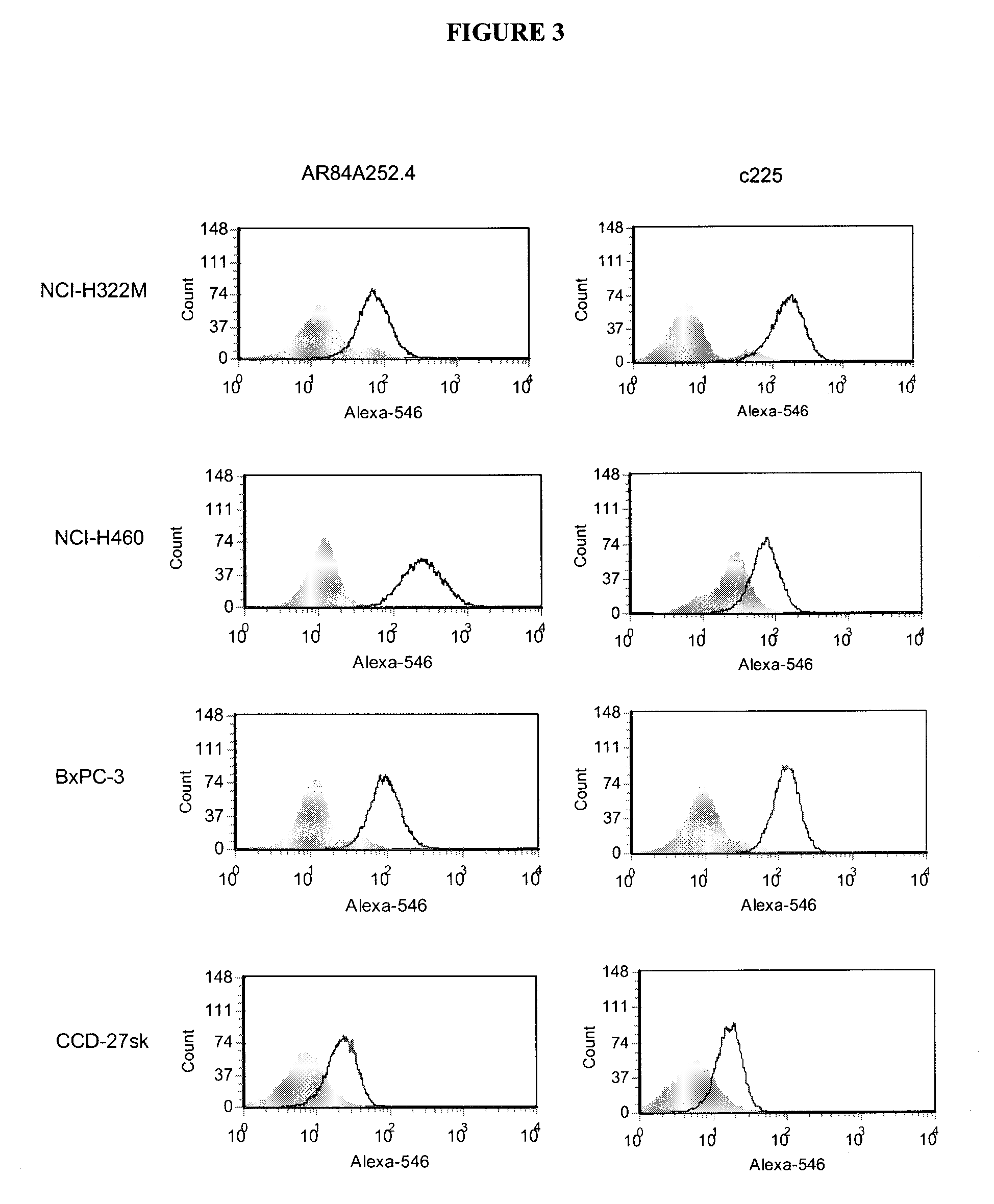Cancerous disease modifying antibodies
a technology of cancerous disease and antibody, which is applied in the field of isolation and production of cancerous disease modifying antibodies, to achieve the effects of prolonging life, prolonging life, and effectively losing function
- Summary
- Abstract
- Description
- Claims
- Application Information
AI Technical Summary
Benefits of technology
Problems solved by technology
Method used
Image
Examples
example 1
Hybridoma Production
Hybridoma Cell Line AR84A252.4
[0096]The hybridoma cell line AR84A252.4 was deposited, in accordance with the Budapest Treaty, with the International Depository Authority of Canada (IDAC), Bureau of Microbiology, Health Canada, 1015 Arlington Street, Winnipeg, Manitoba, Canada, R3E 3R2, on May 29, 2007, under Accession Number 290507-02. In accordance with 37 CFR 1.808, the depositors assure that all restrictions imposed on the availability to the public of the deposited materials will be irrevocably removed upon the granting of a patent. The deposit will be replaced if the depository cannot dispense viable samples.
[0097]To produce the hybridoma that produces the anti-cancer antibody AR84A252.4, a single cell suspension of frozen human lung adenocarcinoma tumor tissue (Genomics Collaborative, Cambridge, Mass.) was prepared in PBS. IMMUNEASY™ (Qiagen, Venlo, Netherlands) adjuvant was prepared for use by gentle mixing. Five to seven week old BALB / c mice were immunize...
example 2
In Vitro Binding
[0102]AR84A252.4 monoclonal antibody was produced by culturing the hybridoma in CL-1000 flasks (BD Biosciences, Oakville, ON) with collections and reseeding occurring twice / week. Standard antibody purification procedures with Protein G Sepharose 4 Fast Flow (Amersham Biosciences, Baie d'Urfé, QC) were followed. It is within the scope of this invention to utilize monoclonal antibodies that are humanized, de-immunized, chimeric or murine.
[0103]Binding of AR84A252.4 to lung (A549, NCI-H23, NCI-H322M, NCI-H460 and NCI-H520), colon (Lovo), breast (MDA-MB-231), pancreatic (BxPC-3), prostate (PC-3) and ovarian (OVCAR-3) cancer cell lines and non-cancer cell lines from skin (CCD-27sk) and lung (Hs888.Lu) was assessed by flow cytometry (FACS). All cell lines were obtained from the American Type Tissue Collection (ATCC, Manassas, Va.)
[0104]Cells were prepared for FACS by initially washing the cell monolayer with DPBS (without Ca++ and Mg++). Cell dissociation buffer (Invitroge...
example 3
In Vivo Tumor Experiments with BxPC-3 Cells
[0106]Example 1 demonstrated that AR84A252.4 had anti-cancer properties against two human cancer cell lines. To demonstrate efficacy against a human cancer cell line in vivo, AR84A252.4 was tested in a BxPC-3 pancreatic cancer xenograft model. With reference to FIGS. 4 and 5, 6 to 8 week old female SCID mice were implanted with 5 million human pancreatic cancer cells (BxPC-3) in 100 microliters PBS solution injected subcutaneously in the right flank. The mice were randomly divided into 2 treatment groups of 10. On the day after implantation, 20 mg / kg of AR84A252.4 test antibody or buffer control was administered intraperitoneally to each cohort in a volume of 300 microliters after dilution from the stock concentration with a diluent that contained 2.7 mM KCl, 1 mM KH2PO4, 137 mM NaCl and 20 mM Na2HPO4. The antibody and control samples were then administered once per week for the duration of the study. Tumor growth was measured about every 7...
PUM
| Property | Measurement | Unit |
|---|---|---|
| median time | aaaaa | aaaaa |
| median time | aaaaa | aaaaa |
| median time | aaaaa | aaaaa |
Abstract
Description
Claims
Application Information
 Login to View More
Login to View More - R&D
- Intellectual Property
- Life Sciences
- Materials
- Tech Scout
- Unparalleled Data Quality
- Higher Quality Content
- 60% Fewer Hallucinations
Browse by: Latest US Patents, China's latest patents, Technical Efficacy Thesaurus, Application Domain, Technology Topic, Popular Technical Reports.
© 2025 PatSnap. All rights reserved.Legal|Privacy policy|Modern Slavery Act Transparency Statement|Sitemap|About US| Contact US: help@patsnap.com



